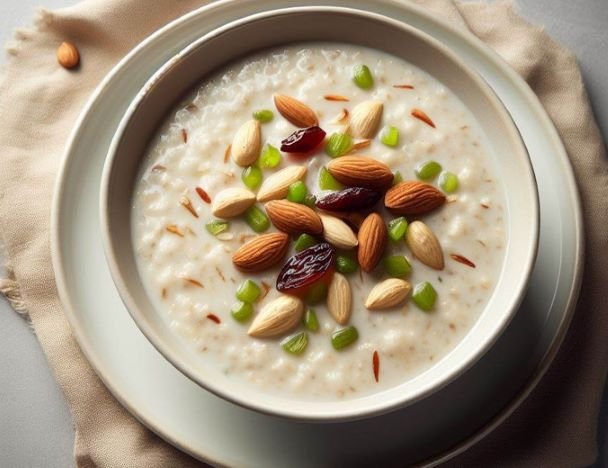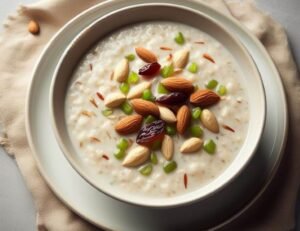Sabudana Payasam Recipe
The very mention of Sabudana Payasam transports me back to my grandmother’s kitchen, a haven filled with the comforting aroma of cardamom, the rich fragrance of ghee, and the sweet allure of jaggery melting into warm milk. As a housewife who’s always been passionate about cooking, and as an ardent food critic, I’ve come to appreciate the nuances of traditional recipes. And the Sabudana Payasam recipe stands tall among them. Its silky texture, interspersed with soft tapioca pearls and crunchy cashews, is truly a gastronomic delight.
What is Sabudana Payasam?
Sabudana Payasam is a traditional South Indian dessert made predominantly from sabudana or tapioca pearls. These pearls, when cooked in milk and jaggery, transform into a delightful, creamy concoction. Infused with cardamom’s aromatic essence and garnished with fried cashews and raisins, the dish is both a visual and sensory treat. Sabudana Payasam is often made during festivals and special occasions, offering a sweet end to a hearty meal.
Sabudana Payasam is not just a dish; it’s an experience, a nostalgic trip down memory lane for many. It epitomizes the rich culinary heritage of India, where ingredients, however simple, are transformed into something truly magical. Whether you’re making it for a festive occasion or simply to satiate a sweet craving, this dish promises to be a delightful addition to your culinary repertoire.
Variations – Sabudana Payasam Recipe
Traditional with a Twist: While the recipe I’ve shared holds true to its traditional roots, several variations can be experimented with.
- With Coconut Milk: Replace regular milk with coconut milk for a vegan version. It also gives a tropical richness to the Payasam.
- With Sago: Some regions in India use sago instead of sabudana. This offers a different texture but retains the essence of the dish.
- With Sugar: If jaggery isn’t available or if you prefer a milder sweetness, you can use sugar as a substitute.
Nutrition – Sabudana Payasam Recipe
A Spoonful of Health: Beyond its deliciousness, Sabudana Payasam also packs a nutritional punch.
- Tapioca Pearls (Sabudana): Rich in carbohydrates, sabudana provides quick energy. It’s often consumed during fasting periods in India for this very reason.
- Milk: A great source of calcium and protein, milk adds to the creaminess of the Payasam while also contributing to its nutritional value.
- Jaggery: A healthier alternative to refined sugar, jaggery is packed with minerals. It aids digestion and is a natural detox, cleaning the liver by flushing out harmful toxins.
- Ghee and Nuts: Ghee, known for its Ayurvedic benefits, is a good source of healthy fats. Cashews and raisins, on the other hand, provide a good dose of iron, magnesium, and antioxidants.
Step by Step Sabudana Payasam Recipe

Sabudana Payasam Recipe
Ingredients
- 80 grams sago pearls / sabudana / Tapioca Tapioca pearls
- 500 ml Milk
- 100 grams jaggery / gur
- 1 tbsp ghee / clarified butter clarified butter
- 10 to 12 cashew
- 10 to 12 Raisins
- 1/4 tsp cardamom powder
- Saffron / Kesar optional
- 1 tbsp coconut optional
Instructions
Preparation
- Start by soaking the sabudana (tapioca pearls) in water for 30 minutes. Ensure they are fully submerged.
- After 30 minutes, drain the water and set the sabudana aside.
Cooking
- In a heavy-bottomed pan, heat the ghee (clarified butter) on a medium flame.
- Once hot, add cashews. Fry them until they become golden, then remove and set them aside.
- In the same ghee, add the raisins. Fry until they puff up and then set aside with the cashews.
- In the same pan, pour the milk. Once the milk becomes warm, add the soaked sabudana.
- Cook the sabudana in milk on a medium flame. Stir occasionally to ensure the sabudana doesn't stick to the bottom.
- When the sabudana turns translucent and the milk thickens slightly, add jaggery to the mixture.
- Mix well until the jaggery dissolves completely.
- Next, add the fried cashews, raisins, cardamom powder, and saffron strands (if using).
- Stir and simmer the payasam for 2-3 more minutes. Turn off the flame once it reaches your desired consistency. If using coconut slices, add them now.
- Serve the Sabudana Payasam hot or cold, as per preference. Garnish with dry fruits, if preferred.

Equipment Used for This Recipe
Notes & Tips
- Sabudana Payasam thickens as it cools. If it becomes too thick, you can add a bit of milk and reheat before serving.
- Using full-fat milk gives the payasam a richer taste, but you can opt for low-fat milk if desired.
- The saffron strands are optional but add a lovely aroma and slight color to the payasam.
- Remember to always use high-quality ingredients for the best taste and texture.
Nutrition Information (Note: Approximate)
FAQs – Sabudana Payasam Recipe
What exactly is Sabudana Payasam?
Sabudana Payasam is a classic South Indian dessert crafted from tapioca pearls or sabudana. When simmered in milk and blended with jaggery, the pearls offer a creamy richness. The dessert is further enhanced with cardamom and often garnished with fried cashews and raisins. It’s a popular choice during festive seasons and special occasions in many Indian households.
How does the taste of Sabudana Payasam differ from other Indian desserts?
While many Indian desserts are rich and heavy, Sabudana Payasam stands out for its lightness, subtle sweetness from jaggery, and the unique texture from tapioca pearls. The infusion of cardamom provides an aromatic touch, setting it apart from other milk-based sweets.
Can I use sugar instead of jaggery?
Certainly! While jaggery brings its own unique flavor and nutritional benefits to the Payasam, sugar can be used as a substitute if you prefer a milder sweetness or if jaggery isn’t readily available.
Is Sabudana Payasam vegan-friendly?
The traditional recipe uses regular milk, making it non-vegan. However, you can easily adapt it to a vegan version by substituting regular milk with coconut milk. This not only makes it vegan but also adds a tropical richness to the dessert.
Why is Sabudana often linked to fasting in India?
Sabudana, or tapioca pearls, is rich in carbohydrates, which provides quick energy. In India, many people consume it during fasting periods to maintain energy levels without consuming grains or lentils.
Can I add fruits to my Sabudana Payasam?
Absolutely! While the traditional recipe doesn’t include fruits, adding sliced bananas, chopped mangoes, or even berries can provide an exciting twist to the dish, enhancing its flavor and nutritional profile.
How long does Sabudana Payasam stay fresh?
Stored in an airtight container in the refrigerator, Sabudana Payasam can stay fresh for up to 2-3 days. Before serving, you might want to warm it a bit, as it thickens upon cooling.
Is there a significant nutritional difference between using sugar and jaggery?
Yes, there is. Jaggery is considered a healthier alternative as it retains more natural minerals than refined sugar. Additionally, jaggery aids in digestion and acts as a natural detox, making it nutritionally superior to refined sugar.
What’s the best time to enjoy Sabudana Payasam?
While traditionally consumed during festivals or special occasions, Sabudana Payasam can be relished anytime you wish to indulge in a creamy, aromatic dessert. It’s perfect as an after-meal treat or even as a comforting evening snack.
Any tips for first-time makers of Sabudana Payasam?
When making Sabudana Payasam, ensure the tapioca pearls are well-soaked and fully translucent before cooking. This ensures a soft texture. Additionally, constant stirring while adding the jaggery prevents lumps and ensures a smooth consistency.
Also see:
———————————————————————————————————
Foodcazt (www.foodcazt.com) is a Food Magazine. We help you discover food. Benefit from our Recipes, Reviews, Food Guides & Articles. We uncover trends, especially for Indian and Asian Cuisines. Please follow us to learn more. Uncover recipes. Learn about trends. Unearth unique restaurants. Find what moves you. Discover what inspires others. We uncover trends, especially for Indian Cuisine and Asian Cuisine. It would mean the world to us, if you follow, like or subscribe on: YouTube, Facebook, Twitter, Instagram.



